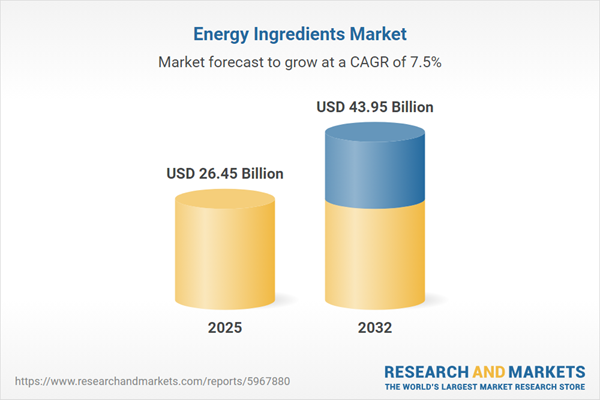Speak directly to the analyst to clarify any post sales queries you may have.
The energy ingredients market is experiencing accelerated evolution as B2B organizations adapt to emerging health priorities, dynamic compliance landscapes, and elevated consumer standards. For senior executives, timely, actionable analysis of this sector supports risk mitigation, value creation, and sustained resilience amid global change.
Market Snapshot: Global Energy Ingredients Market Size and Growth
The global energy ingredients market is valued at USD 24.63 billion in 2024 and projected to reach USD 26.45 billion by 2025, achieving a compound annual growth rate (CAGR) of 7.50%. By 2032, expansion is set to approach USD 43.95 billion. Several trends are driving this growth, including constant demand for clean label solutions, innovation in production technologies, and capital allocation toward manufacturing scale-up. Industry leaders are moving swiftly to align product portfolios with consumer preferences and regulatory shifts, while managing compliance across multiple regions to access new opportunities and enable long-term performance.
Scope & Segmentation of the Energy Ingredients Market
- Ingredient Types: Key energy ingredients such as B Vitamins, Caffeine, Ginseng, Guarana, and Taurine serve to support cognitive stimulation and physical energy. Their inclusion helps organizations diversify wellness-oriented offerings.
- Source Options: Businesses weigh natural ingredients versus synthetic alternatives, balancing regulatory compliance and market entry requirements to inform sourcing relationships and enhance brand distinction.
- Applications: These ingredients find critical application in beverages, dietary supplements, functional foods, and nutrition bars, meeting institutional and convenience-driven B2B needs while promoting wellness solutions.
- Form Factors: Product formats like granules, liquids, powders, tablets, and capsules provide operational flexibility. This supports tailored product delivery and efficient supply chain management to meet diverse market demands.
- Distribution Channels: The sector serves institutional buyers, specialty distributors, e-commerce providers, and large online retailers, offering suppliers access to mature markets and emerging high-growth segments.
- Regions Covered: With North America, Europe, Middle East & Africa, and Asia-Pacific as key regions, companies deploy region-specific partnership models to navigate regulations and address distinctive consumer needs.
- Leading Companies: Dominant players include Cargill, Archer-Daniels-Midland, Koninklijke DSM, Kerry Group, Ajinomoto, Ingredion, Tate & Lyle, Roquette Frères, Evonik Industries, and International Flavors & Fragrances. They leverage advanced capabilities and global networks to gain market share and broaden portfolios.
- Technological Advancements: Innovations such as microencapsulation, artificial intelligence-led manufacturing, new ingredient delivery mechanisms, sustainable extraction processes, and digital automation are raising quality standards and speeding time-to-market for new solutions.
Key Takeaways for Strategic Decision-Makers
- Prioritizing health-focused sourcing and transparent supply chains builds trust with B2B customers and meets rising demand for credible ingredient origins.
- Accelerating sustainable practices and investing in advanced ingredient delivery methods streamlines cross-border expansion and eases compliance with diverse regulatory frameworks.
- Optimizing business with robust analytics enables improved customer segmentation, fostering tailored offerings and highly targeted B2B engagement.
- Strengthening supplier networks and diversifying sourcing partners helps mitigate operational risks and supports reliable global distribution capabilities.
- Forming mutually beneficial regional partnerships enhances local adaptability, ensures alignment with evolving regulations, and enables co-development of market-specific solutions.
Tariff Impact and Supply Chain Resilience
Recent changes in U.S. tariffs are leading energy ingredient companies to adapt sourcing strategies and expand their supplier bases. Increased focus on near-sourcing and advanced forecasting is maintaining supply continuity, improving transparency, and ensuring compliance with evolving trade policies. These adaptations are critical for continuity and resilience amid shifting geopolitical and regulatory pressures.
Methodology & Data Sources
This analysis synthesizes findings from executive interviews, focused industry surveys, trusted secondary research, and integrated statistical review. The method ensures a validated, actionable foundation to inform senior leadership decisions regarding investment, innovation, and risk evaluation in the energy ingredients market.
Why This Report Matters
- Equips executive teams with granular insights for informed innovation, investment assessment, and enterprise risk management within a complex, shifting sector.
- Provides comprehensive segmentation and emerging trend intelligence to empower strategic planning and opportunity identification during business transitions.
- Highlights the importance of technology adoption and regional partnership models for building robust, future-ready operational strategies.
Conclusion
This report offers senior decision-makers clear analysis for anticipating market changes, enabling proactive strategy development, and securing a competitive position within the evolving energy ingredients landscape.
Additional Product Information:
- Purchase of this report includes 1 year online access with quarterly updates.
- This report can be updated on request. Please contact our Customer Experience team using the Ask a Question widget on our website.
Table of Contents
3. Executive Summary
4. Market Overview
7. Cumulative Impact of Artificial Intelligence 2025
Companies Mentioned
The companies profiled in this Energy Ingredients market report include:- Cargill, Incorporated
- Archer-Daniels-Midland Company
- Koninklijke DSM N.V.
- International Flavors & Fragrances Inc.
- Kerry Group PLC
- Ajinomoto Co., Inc.
- Ingredion Incorporated
- Tate & Lyle PLC
- Roquette Frères
- Evonik Industries AG
Table Information
| Report Attribute | Details |
|---|---|
| No. of Pages | 192 |
| Published | November 2025 |
| Forecast Period | 2025 - 2032 |
| Estimated Market Value ( USD | $ 26.45 Billion |
| Forecasted Market Value ( USD | $ 43.95 Billion |
| Compound Annual Growth Rate | 7.5% |
| Regions Covered | Global |
| No. of Companies Mentioned | 11 |









